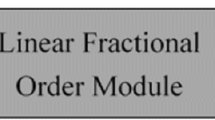Abstract
Aiming at the difficult identification of fractional order Hammerstein nonlinear systems, including many identification parameters and coupling variables, unmeasurable intermediate variables, difficulty in estimating the fractional order, and low accuracy of identification algorithms, a multiple innovation Levenberg–Marquardt algorithm (MILM) hybrid identification method based on the fractional order neuro-fuzzy Hammerstein model is proposed. First, a fractional order discrete neuro-fuzzy Hammerstein system model is constructed; secondly, the neuro-fuzzy network structure and network parameters are determined based on fuzzy clustering, and the self-learning clustering algorithm is used to determine the antecedent parameters of the neuro-fuzzy network model; then the multiple innovation principle is combined with the Levenberg–Marquardt algorithm, and the MILM hybrid algorithm is used to estimate the linear module parameters and fractional order. Finally, the academic example of the fractional order Hammerstein nonlinear system and the example of a flexible manipulator are identified to prove the effectiveness of the proposed algorithm.

















Similar content being viewed by others
Data availability
At present, this paper completely describes the theoretical research and does not analyze the data set during the research period. The collection of data set is random according to different readers, but some codes can be provided by contacting the corresponding author.
References
Abu Arqub, O.: Solutions of time-fractional Tricomi and Keldysh equations of Dirichlet functions types in Hilbert space. Numer. Methods Partial Differ. 34(5), 1759–1780 (2018)
Del-Castillo-Negrete, D., Carreras, B.A., Lynch, V.E.: Front dynamics in reaction-diffusion systems with Levy flights: a fractional diffusion approach. Phys. Rev. Lett. 91(1), 018302 (2003)
Written, T.A.: Insights from Soft Condensed Matter. Springer, Berlin (1999)
Dingyu, X.: Fractional Calculus and Fractional Control. Science Press, Beijing (2018)
Cheng, J.: Theory of Fractional Difference Equations. Xiamen University Press, Xiamen (2011)
Victor, S., Malti, R.: Parameter and differentiation order estimation in fractional models. Automatica 49(4), 926–935 (2013)
Fahim, S.M., Ahmed, S., Imtiaz, S.A.: Fractional order model identification using the sinusoidal input. ISA Trans. 83(1), 35–41 (2018)
Karima, H., Tounsia, D., Maamar, B.: Identification of Fractional Hammerstein systems with application to a heating process. Nonlinear Dyn. 2, 10058 (2019)
Shalaby, R., Mohammad, E.H., Belal, A.Z.: Fractional order modeling and control for under-actuated inverted pendulum. Commun. Nonlinear Sci. Numer. Simul. (2019). https://doi.org/10.1016/j.cnsns.2019.02.023
Malti, R., Aoun, M., Oustaloup, A.: Systhesis of fractional kautz-like basis with two periodically repeating complex conjugate modes. In: Control, Communication and Signal Processing, First International Symposium (2004)
Jonscher, A.K.: Dielectric relaxation in solids. J. Phys. D Appl. Phys. 32(14), 57–69 (1999)
Westerlund, S., Ekstam, L.: Capacitor theory. IEEE Trans. Dielectrics Electr. Insulation. 1(5), 826–839 (1994)
Cheng, T., Zhishan, L., Juqiu, Z.: Nonlinear control of fractional boost converter in pseudo-continuous mode of inductor current. Acta Physica Sinica. 25(1), 63–69 (2014)
Abuaisha, T., Kertzscher, J.: Fractional-order modeling and parameter identification of electrical coils. Fract. Calc. Appl. Anal. 22(1), 193–216 (2019)
Boubaker, S.: Identification of nonlinear Hammerstein system using mixed integer-real coded particle swarm optimization: application to the electric daily peak-load forecasting. Nonlinear Dyn. 90(2), 797–814 (2017)
Hu, Y.S., Fan, Y., Wei, Y.H., Wang, Y., Liang, Q.: Subspace-based continuous-time identification for fractional order systems from non-uniformly sampled data. Int. J. Syst. Sci. 47(1), 122–134 (2016)
Wang, J., Wei, Y., Liu, T., Li, A., Wang, Y.: Fully parametric identication for continuous time fractional order Hammerstein systems. J. Franklin Inst. 357, 651–666 (2020)
Ding, F., Chen, T.W.: Identification of Hammerstein nonlinear ARMAX systems. Automatica 41(9), 1479–1489 (2005)
Gomez, J.C., Baeyens, E.: Subspace-based identification algorithms for Hammerstein and Wiener models. Eur. J. Control. 11(2), 127–136 (2005)
Bai, E.W., Li, D.: Convergence of the iterative Hammerstein system identification algorithm. IEEE Trans. Autom. Control 49(11), 1929–1940 (2004)
Narendra, K.S., Gallman, P.G.: An iterative method for the identification of nonlinear systems using a Hammerstein model. IEEE Trans. Autom. Control 11(3), 546–550 (1966)
Chen, H.F.: Pathwise convergence of recursive identification algorithms for Hammerstein systems. IEEE Trans. Autom. Control 49(10), 1641–1649 (2004)
Jing, X.J.: Frequency domain analysis and identification of blockoriented nonlinear systems. J. Sound Vib. 330(22), 5427–5442 (2011)
Yu, C.P., Zhang, C.S., Xie, L.H.: Blind identification of non-minimum phase ARMA systems. Automatica 49(6), 1846–1854 (2013)
Zennir, Y., Elhadi, G., Riad, B.: Robust fractional multi-controller design of inverted pendulum system. In: 2016 20th International Conference on System Theory, Control and Computing (ICSTCC). IEEE. (2016)
Caputo, M.: Linear models of dissipation whose Q is almost frequency independent. Part II. Geophys. J. Int. 13(5), 529–539 (1967)
Monje, C.A., Chen, Y.Q., Vinagre, B.M., et al.: Fractional-Order Systems and Controls: Fundamentals and Applications. Springer, Berlin (2010)
De Moor, B., De Gersem, P., De Schutter, B., et al.: DAISY: a database for identification of systems. JOURNAL A. 38, 4–5 (1997)
Funding
This work was supported by the National Natural Science Foundation of China (Grant number 61863034) and the Autonomous Region Graduate Research and Innovation Project (Grant number XJ2019G060).
Author information
Authors and Affiliations
Corresponding authors
Ethics declarations
Conflict of interest
The authors declare that there is no conflict of interest with respect to the research, authorship, and/or publication of this paper.
Additional information
Publisher's Note
Springer Nature remains neutral with regard to jurisdictional claims in published maps and institutional affiliations.
Rights and permissions
About this article
Cite this article
Zhang, Q., Wang, H. & Liu, C. MILM hybrid identification method of fractional order neural-fuzzy Hammerstein model. Nonlinear Dyn 108, 2337–2351 (2022). https://doi.org/10.1007/s11071-022-07303-y
Received:
Accepted:
Published:
Issue Date:
DOI: https://doi.org/10.1007/s11071-022-07303-y




